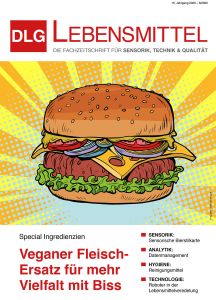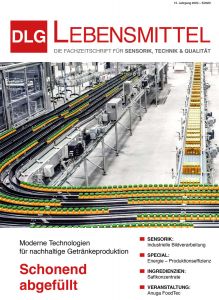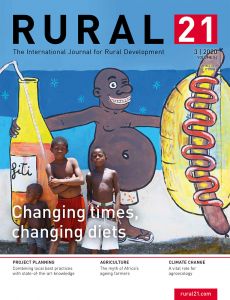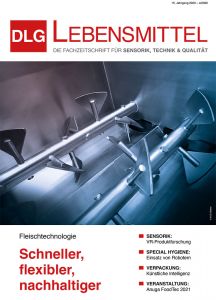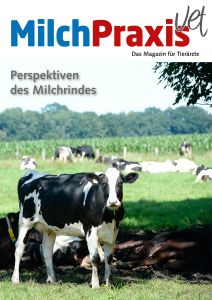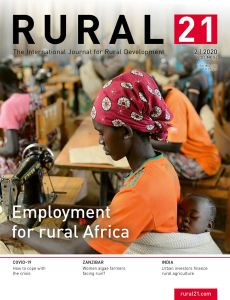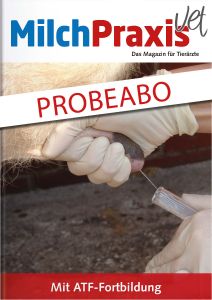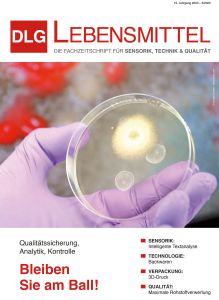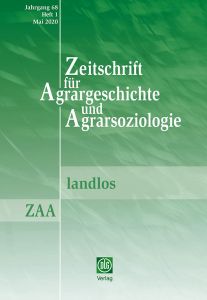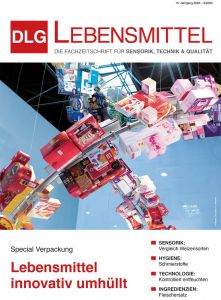Verstecke Angebote
-
DLG Lebensmittel 6/2020
Im Mittelpunkt des Heftes stehen Fachartikel und Praxisbeiträge zu den Themen "Lebensmittelqualität", "Sensorik", "Lebensmitteltechnologie", "Ingredienzien" sowie "Kommunikation/Marketing". Ein aktueller Blick in die Entwicklung der Lebensmittelmärkte rundet das Angebot ab. Damit werfen wir einen ganzheitlichen Blick auf die „Welt der Lebensmittel“ – von der Entwicklung, über die Produktion bis zur Vermarktung.
Erfahren Sie mehr -
DLG Lebensmittel 5/2020
Im Mittelpunkt des Heftes stehen Fachartikel und Praxisbeiträge zu den Themen "Lebensmittelqualität", "Sensorik", "Lebensmitteltechnologie", "Ingredienzien" sowie "Kommunikation/Marketing". Ein aktueller Blick in die Entwicklung der Lebensmittelmärkte rundet das Angebot ab. Damit werfen wir einen ganzheitlichen Blick auf die „Welt der Lebensmittel“ – von der Entwicklung, über die Produktion bis zur Vermarktung.
Erfahren Sie mehr -
Rural 21 (engl. Ausgabe 3/2020)
Focus 3/2020: Changing times, changing diets
In its 2019 publication Food in the Anthropocene, the EAT-Lancet Commission described the link between nutritional targets and environmental sustainability. In brief, the study argues that diets and food production will need to change in order to improve health and avoid damage to the planet, emphasising that people will have to eat more fruit, vegetables, nuts and seeds, legumes and whole grains while reducing the consumption of ruminant meat in particular. Setting out from this, the authors presented a proposition for a global reference diet. Whereas it is undisputed that the recommendations of the Lancet Commission point in the right direction, the question remains how the world population can be urged to take precisely this course.
Erfahren Sie mehr -
DLG Lebensmittel 4/2020
Im Mittelpunkt des Heftes stehen Fachartikel und Praxisbeiträge zu den Themen "Lebensmittelqualität", "Sensorik", "Lebensmitteltechnologie", "Ingredienzien" sowie "Kommunikation/Marketing". Ein aktueller Blick in die Entwicklung der Lebensmittelmärkte rundet das Angebot ab. Damit werfen wir einen ganzheitlichen Blick auf die „Welt der Lebensmittel“ – von der Entwicklung, über die Produktion bis zur Vermarktung.
Erfahren Sie mehr -
ABONNEMENT: MilchPraxis vet MIT FORTBILDUNG
Ausgabe für Tierärzte
Lesen Sie 4 x jährlich MilchPraxis vet mit diesen Vorzügen: inkl. Fortbildungsmöglichkeit E-Learning mit mind. 4 ATF-Punkten/Jahr, inkl. E-Paper, vergünstigte (Online-) Seminare, vergünstigte Teilnahme an Fachtagung CattleCamp
Erfahren Sie mehr -
Rural 21 (engl. Ausgabe 2/2020)
Focus 2/2020: Employment for rural Africa
Many people in the Global South have no option to earn an income enabling them a life beyond poverty, not to mention a decent living. The situation is particularly volatile in Africa, for the population there will double by 2050, and every year, 25 million new jobs need to be created for the surge of young people entering the labour market. These young people are more educated, more entrepreneurial, more savvy and more technical-skilled than any other generation before them. So this is a huge potential that can be put to use – provided that the existing hurdles can be cleared, and that the impacts of the corona crisis can be contained as quickly as possible.
Erfahren Sie mehr -
DLG Lebensmittel 3/2020
Im Mittelpunkt des Heftes stehen Fachartikel und Praxisbeiträge zu den Themen "Lebensmittelqualität", "Sensorik", "Lebensmitteltechnologie", "Ingredienzien" sowie "Kommunikation/Marketing". Ein aktueller Blick in die Entwicklung der Lebensmittelmärkte rundet das Angebot ab. Damit werfen wir einen ganzheitlichen Blick auf die „Welt der Lebensmittel“ – von der Entwicklung, über die Produktion bis zur Vermarktung.
Erfahren Sie mehr -
Zeitschrift für Agrargeschichte und Agrarsoziologie 1/2020
Schwerpunkt dieser Ausgabe: "Landlos", erscheint 2x jährlich (April und Oktober)
Erfahren Sie mehr -
DLG Lebensmittel 2/2020
Im Mittelpunkt des Heftes stehen Fachartikel und Praxisbeiträge zu den Themen "Lebensmittelqualität", "Sensorik", "Lebensmitteltechnologie", "Ingredienzien" sowie "Kommunikation/Marketing". Ein aktueller Blick in die Entwicklung der Lebensmittelmärkte rundet das Angebot ab. Damit werfen wir einen ganzheitlichen Blick auf die „Welt der Lebensmittel“ – von der Entwicklung, über die Produktion bis zur Vermarktung.
Erfahren Sie mehr

